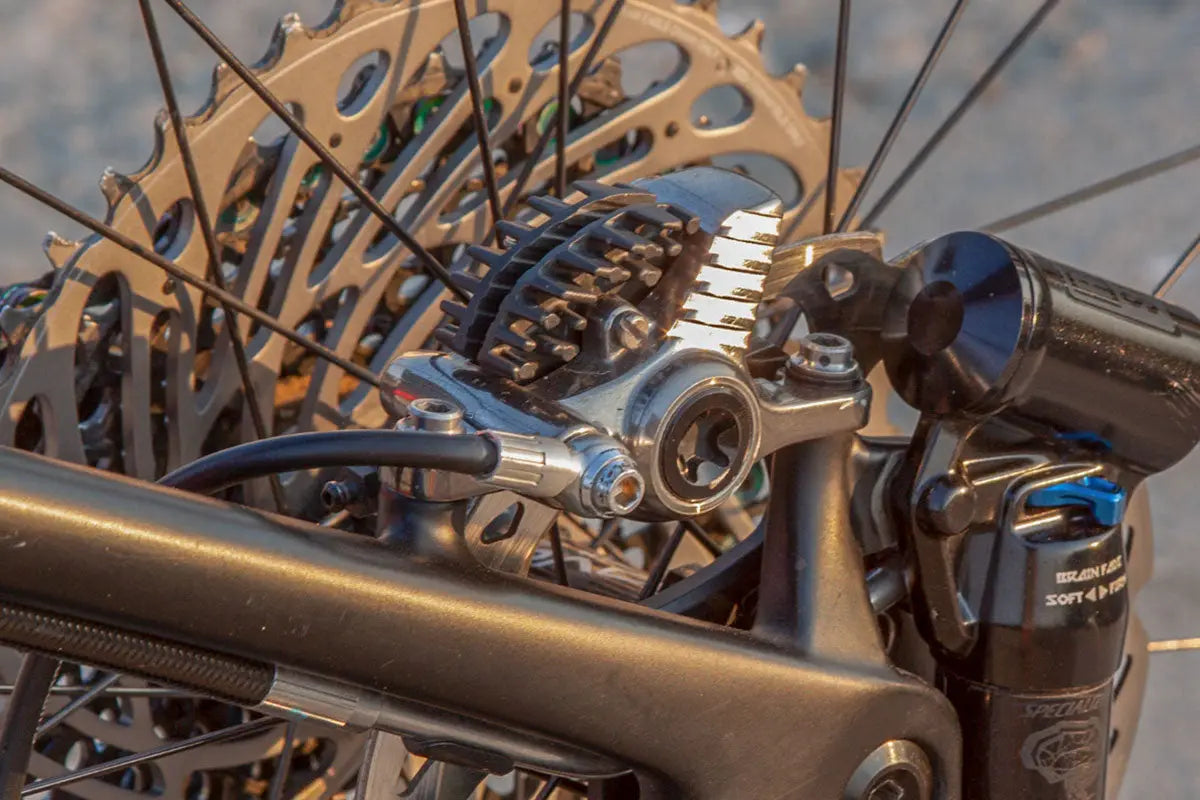Since Kogel’s brake pad launch earlier this year, we have received a lot of questions about the cooling fins on Shimano’s brake pads and why they are lacking on the Kogel brake pads.
Let’s dive in and have a closer look and talk about heat management!

OG Disc-brake heat management
But first, a bit of history. In the early days of disc brakes on mountain bikes, it was very common for brakes to overheat on long descents.
Small rotors and braking systems not fully developed, by today’s standards, caused many bikers to be stuck on a descent with their levers pulling straight to the bar. Not a fun thing when you have another half-hour of descending ahead of you.
The reason for this was that heat caused by friction between pad and rotor built up in the system making discs super-hot. (I personally walked around with the famous cat 5 tattoo on my calf for half a summer, this time not caused by a chainring, but more permanently applied with a red rotor.)
The heat from all that friction was also transferred back into the pads and calipers and from there into the brake fluid in your hydraulic system.
Once the brake fluid/oil hits a boiling point and starts forming bubbles: poof! Braking gone. Your lever pulls straight back to the bar and little to no pressure is applied between pads and rotor.
Disc-brake heat management today
Over the past two decades or so, many things have improved. For example, we found out that the best way to manage heat is by simply running larger rotors.
Today, braking forces are lower since your calipers are further away from the hub; and, as a bonus, the surface area is larger, which allows for better cooling.
Other details have also improved, like Shimano’s use of ceramic pistons. Ceramic materials are excellent heat insulators, so any components that separate brake pads and brake fluids using ceramics is a step forward.

About those cooling fins
The addition of aluminum cooling fins a few years ago to higher-end Shimano pads was a great way to increase the surface area: more things for the wind to grab onto means better cooling. Awesome!
The fins are made of aluminum, which is a metal that transfers heat very well. It warms up fast and cools down fast. Perfect for fins. (Maybe not as good for backing plates on discs since aluminum might soften when rotors heat up to 400 Celsius, but we’ll leave that speculation for another post.)
Good heat vs bad
Brake pads need to have some heat in them to work well, aka achieve maximum friction; which is why I chose the title of this article.
To me it seems weird that if heat in the pads is good and heat in the hydraulic system is bad, we try to cool down the brake pads?
Pulling heat out of the pads will just cause them to take longer to warm up and operate at less than their best performance. It seems strange that in order to cool down the caliper, piston and brake fluid, you would cool down the pads.
Another issue is the size of the fins: take a good look at your 180mm rotor. It sits in the perfect position to grab airflow and cool down on a descent. Now roughly estimate the surface area of that rotor and do the same for the surface area of those teeny tiny fins sticking out of your caliper.
Are those fins really big enough to make a significant difference in cooling? I have no empirical data on this, but my first hunch is ‘not really’.

Introducing Ceramic Barrier
If heat is good in the pads and to some degree in the rotors, but not good everywhere else, it seems smart to set up a system to separate the two.
I have already mentioned that ceramic materials are excellent insulators. It is used in spark plugs and old school breakers because they are equally bad at conducting electricity.
This is why the we added a ceramic layer on the back of all Kogel disc brake pads to stop heat transfer right at the point where it matters most, back into the brake fluid.
A nice additional perk is that this layer reflects heat back into the pads, resulting in a shorter time to reach operating temperature and their best performance.
So, here’s to keeping heat out of your brake fluid and in the pads! The next project to think about might be a rotor that does not get super-hot. I’m not looking to walk around for another summer with a crescent moon shaped burn mark on my calf anytime soon.

